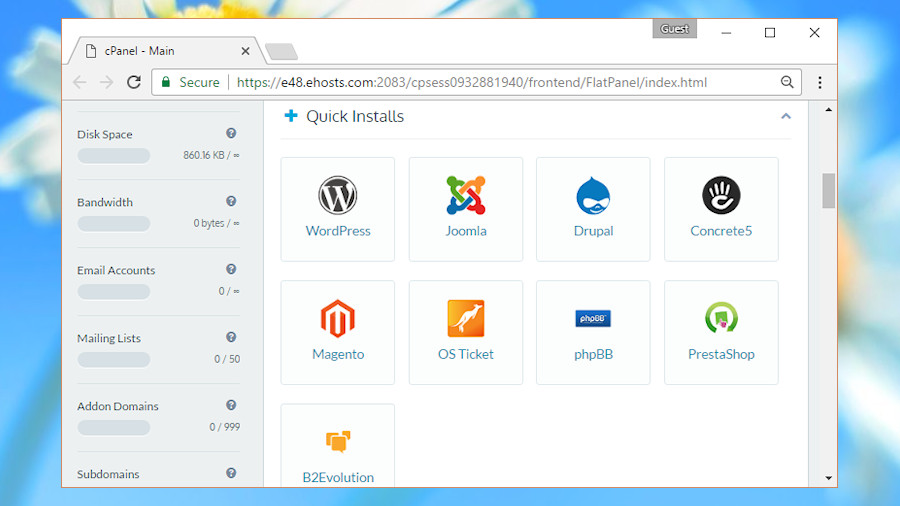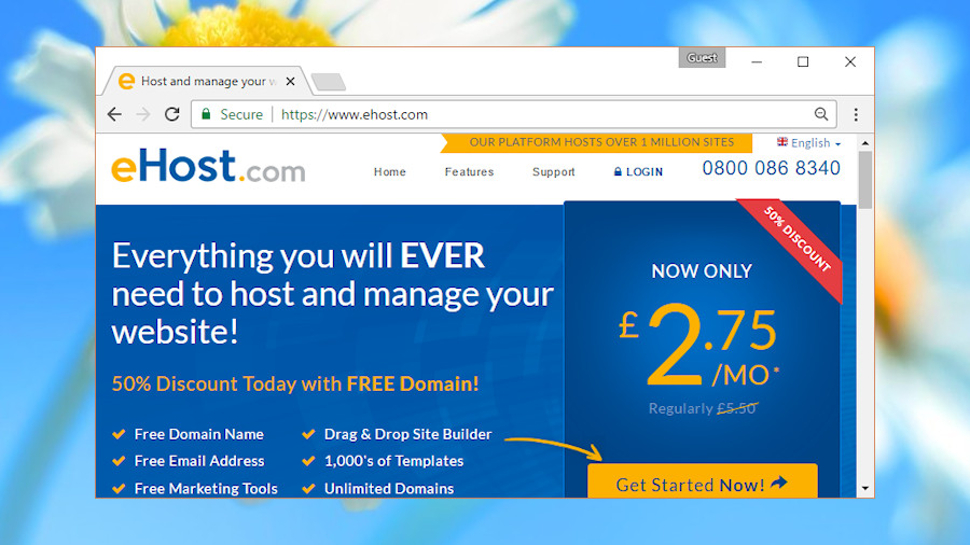TechRadar Verdict
eHost has closed doors.
Why you can trust TechRadar
Update from the editor:
eHost has closed its doors to business. Existing clients have had their site migrated to either siteleo.com or justhost (which has also closed doors and is using sister company BlueHost).
Some website hosting companies market themselves on price, others on features, but eHost tries both. The company claims to offer ‘everything you will ever need to host and manage your website’ for the lowest possible cost.
Could this be true? The feature list is impressive, with unlimited storage space, bandwidth, databases, email accounts, even domains. Other hosts usually save multi-domain hosting for their high-end business accounts, but eHost offers it as standard.
A free domain name, drag-and-drop website builder and thousands of templates are included. There’s also a one-click installer for WordPress, shopping carts and other applications. Not to mention a cPanel-powered hosting manager which provides a standard way to get to grips with the system, plus eHost gives you all-round 24-hour support via the website, email or live chat.
The website tries to win you over with even more features, although most of these are typically included everywhere (email forwarding, visitor stats), or so vaguely described that it's hard to guess their value (for example: ‘access to online marketing guides’).
The headline price for all this looks amazing at a quoted £2.75 ($3.45) a month, but that only applies if you buy three years of hosting upfront. Opt for a one-year plan and you'll pay £10 ($12.50) a month, a similar price to many other hosts. HostGator's Baby plan is similar to eHost and renews for around £8 ($10) a month, and its Business plan renews at £12 ($15) a month but gives you private SSL as well.
So this web host isn't quite as cheap as it first looks, then, but there's still real value here for demanding users, and a 30-day ‘no questions asked’ money-back guarantee if you're not happy. The next step: sign up and see how the service works.
Sign up to the TechRadar Pro newsletter to get all the top news, opinion, features and guidance your business needs to succeed!
- Check out the best website hosting services in this roundup.
Account setup
Signing up with eHost is easier than usual as there's only one shared hosting product to consider. We'd still like to see more low-level detail on what the plan includes and what it doesn't, but if you're happy with the site description it's just a matter of clicking ‘Get Started Now!’ and following the instructions.
The first step is to choose your new domain, or enter the name of a domain you own already. Choose the second option and eHost displays a thoughtful note explaining that you'll need to make a few changes with your existing registrar to point the domain to your new account, and that the Help Centre can tell you more. Experienced users will know this already, but it's a helpful hint for newbies.
The next two pages ask you to enter all your regular contact data: name, email and physical address along with your phone number. If you didn't know already, this is the stage where you'll realise that £2.75 ($3.45) a month is excluding VAT and requires you paying for 36 months upfront. You can drop to monthly payments but they'll be £14 ($17.50), which probably won't appeal, either.
Find a price you can accept and all that's left to do is complete the billing form (card payments and PayPal are supported). We passed on our PayPal details and everything worked as expected.
After the payment went through eHost displayed further pages asking if we'd like to purchase some add-ons. These were either overpriced – SiteLock for £30 ($37.50) in the first year, £60 ($75) afterwards – or not for us (‘get more traffic’ plans). You need to pay attention, though, because there are additional buttons saying ‘no thanks’ or ‘confirm purchase’, and it's easy to get confused about whether you are confirming the initial purchase, or giving eHost permission to add something else. We made sure to read everything carefully before we clicked.
The final step was a surprise. eHost explained that it needed to set up our account for cPanel-based hosting or the drag-and-drop website builder. Every other host we've seen provides both options and allows you to choose and switch whenever you like, but eHost makes this an either-or decision – and it's crucial.
What the eHost site doesn't explain clearly is that although the hosting account supports multiple domains, this only applies to cPanel hosting. If you choose the website builder this covers you for one domain only, and you'll need to purchase a separate account to host anything else.
We clicked cPanel for flexibility, then the signup process was over and we were told to wait for a welcome email.

Creating a site
Logging in to eHost for the first time took us to a nicely designed customer portal, stripped back and straightforward. While many hosts use their portals as marketing tools, cramming them with so many options that it's difficult to see what you should do next, eHost displays your domains as soon as you log on. There are buttons to view the domain, check stats or email right away, or you can hit Manage to work on the site.
eHost uses cPanel for its host management, nicely presented via a responsive (we think) Flat Panel theme. This has all the usual advanced and extended tools that experienced users need, from phpMyAdmin and SpamAssassin to AWSTATS, Webalizer, PHP Pear and Ruby on Rails. But large icons and a flat button format makes the interface less intimidating for beginners, and the options are also neatly arranged to keep the most commonly-used tools at the top.
Our cPanel included one-click installers for WordPress, Joomla, Drupal, Concrete5, Magento, OS Ticket, phpBB, PrestaShop, B2Evolution and more. These are powered by Mojo MarketPlace, which means more attempts to try to sell you stuff during installation (we were offered items like ‘Install your WordPress theme’, or ‘Backup your WordPress Website’ for $99 – around £77).
We much prefer frameworks as they give you more help to explore the apps on offer, but if you only need to install something like WordPress it's not a big deal. eHost's system will get you set up just as easily as anything else, and once the install is over you won't need to see any of Mojo’s ads again.
If you've created your website already and just need to upload it, the usual cPanel File Manager, FTP and SSH modules are just a click or two away. The cPanel theme has File Manager immediately visible on the left-hand sidebar, too, so even novice users will spot it right away.
The firm’s Website Builder is easy to use and has some appealing templates, but as we mentioned above, it comes with a couple of very significant catches. Opting for Website Builder not only means you don't get access to the full cPanel, but it also can't be used to create and host multiple domains within the same package (you would have to purchase a new plan for each site). Unless you're 100% sure what you want to do, we'd recommend avoiding Website Builder and finding some other way to create your site.

Performance
We started our eHost testing with its website support, and the first impressions weren't good. There's a support link on the Control Panel but it opens the support site in a new page, and this page displays only three featured articles and a search box. We're normally in favour of keeping websites simple, but in this case we'd like to see more FAQs or at least links to topics. Oddly, eHost does organise its articles into categories, they're just not displayed on the opening page.
We entered ‘Import WordPress’ in the search box and were much more impressed by the results. Not only were there plenty of relevant hits, but they were sorted into a sensible order with the most important at (or near) the top.
The individual articles weren't the best we've seen, as some were a little too brief, and others short on the screenshots that rival outfits can provide. But they still offered plenty of useful guidance, pointing users in the right direction and giving them enough information to get the job done.
We ran searches with single keywords like MySQL, Apache and PHP. That can be a useful way to test the number of articles on a topic and how they're prioritised, and again eHost did very well. Not only were we presented with lots of useful information, but key articles appeared high on the list, so for example the very first MySQL document was titled: ‘How do I create a MySQL database, a user, and then delete if needed?"
Live chat is available if you need more advice. We checked this out with some mid-range queries about eHost products – nothing very technical, but with some detailed knowledge required of the service – and had good results. Response times ranged from ten seconds to six minutes, the agents got straight to the point without needing to ask extra questions, and gave us clear and accurate answers right away.
Ticket and email support is available, too. This may take a while – our first ticket didn't get a response for more than seven hours – but the agent once again gave an accurate answer to our query.
We completed our testing by running a few simple performance checks on our eHost server. This seemed to be in Texas, so there was a small lag in response time from the UK, but US connections were speedy and the server was a little faster than average. The exact speeds you'll see will vary depending on your location, type of site and the server you get, but our tests didn't find any major issues that might slow you down.
Final verdict
eHost's introductory rates are good value if you'll use its multi-domain hosting and don't need the drag-and-drop Site Builder, but beware – the price is much higher for shorter plans.
- We've also highlighted the best website hosting services
We've also featured the:
- Best cheap webhosting
- Best shared hosting
- Best reseller hosting
- Best VPs hosting
- Best dedicated server hosting
- Best colocation hosting
- Best Wordpress hosting
- Best cloud hosting
- Best Linux hosting
- Best Windows hosting
- Best ecommerce hosting
- Best small business web hosting
- Best managed web hosting
- Best email hosting providers

Mike is a lead security reviewer at Future, where he stress-tests VPNs, antivirus and more to find out which services are sure to keep you safe, and which are best avoided. Mike began his career as a lead software developer in the engineering world, where his creations were used by big-name companies from Rolls Royce to British Nuclear Fuels and British Aerospace. The early PC viruses caught Mike's attention, and he developed an interest in analyzing malware, and learning the low-level technical details of how Windows and network security work under the hood.
